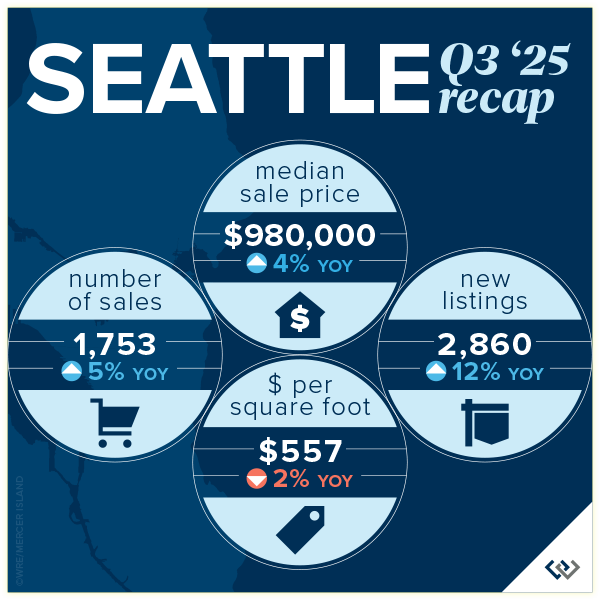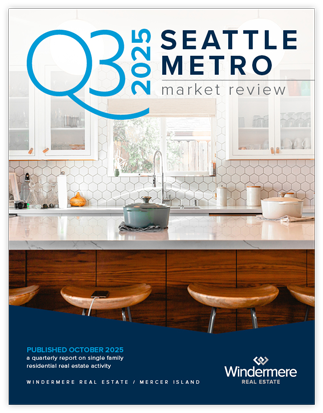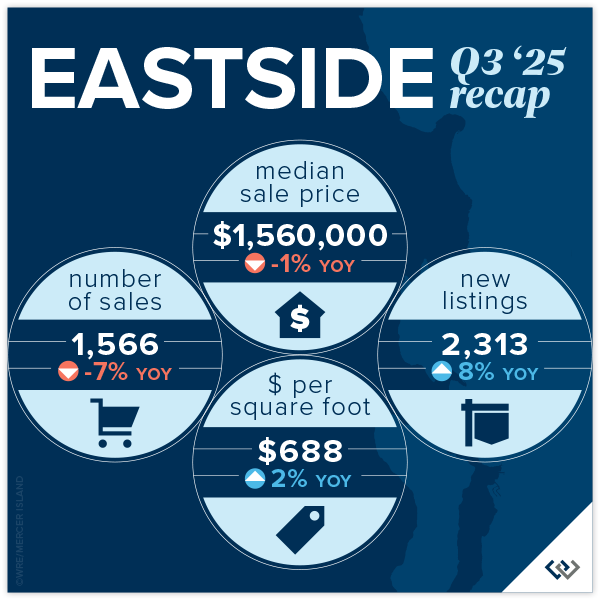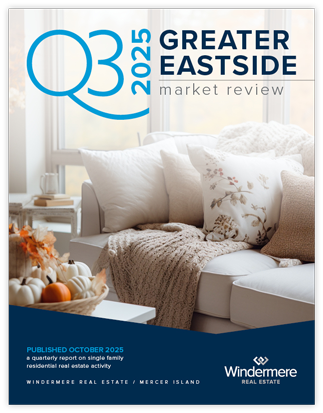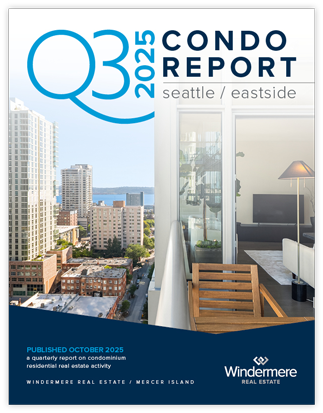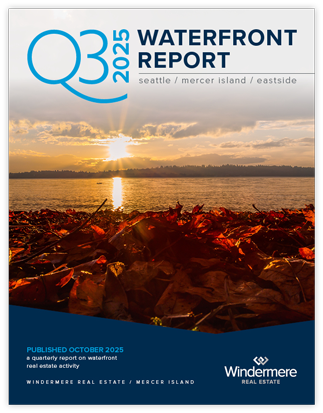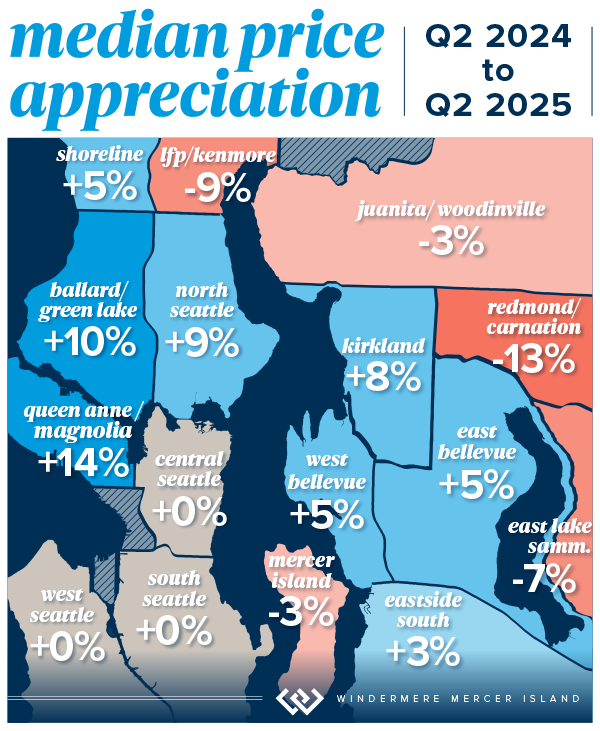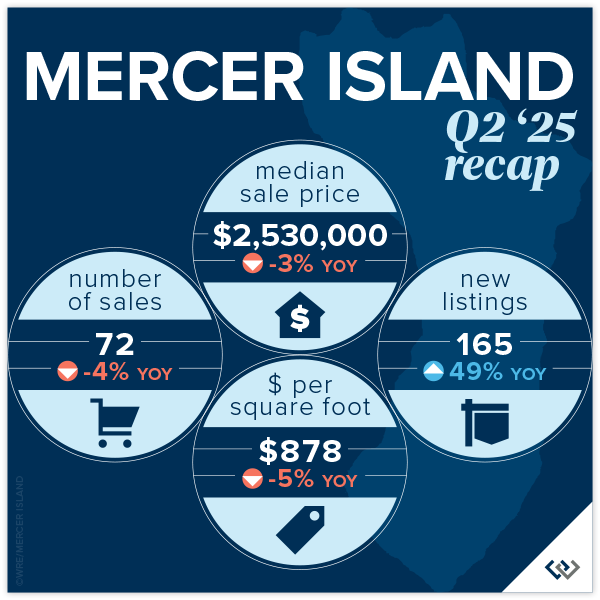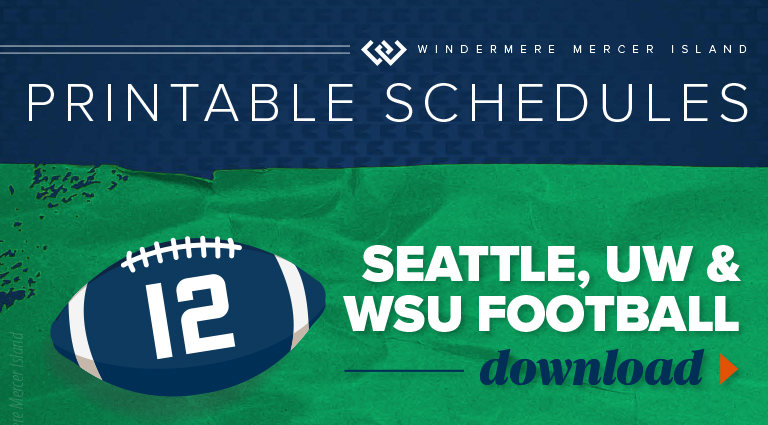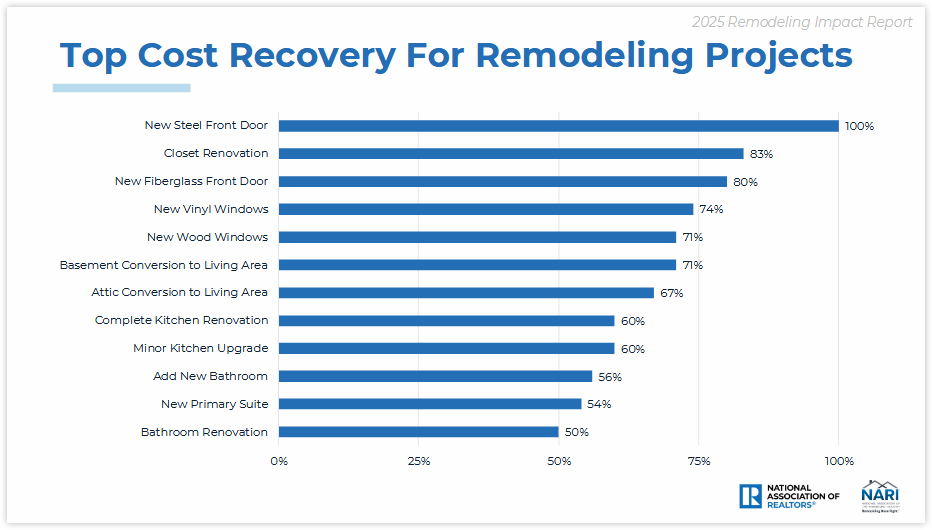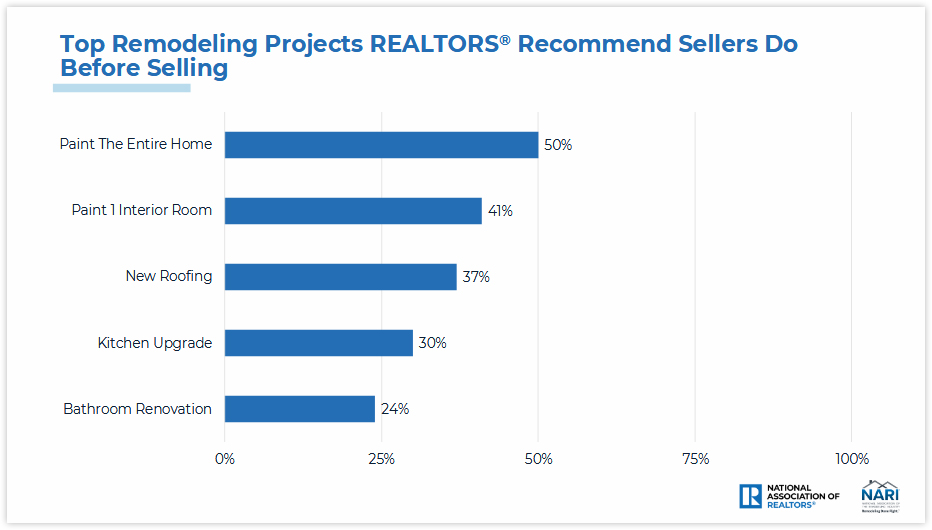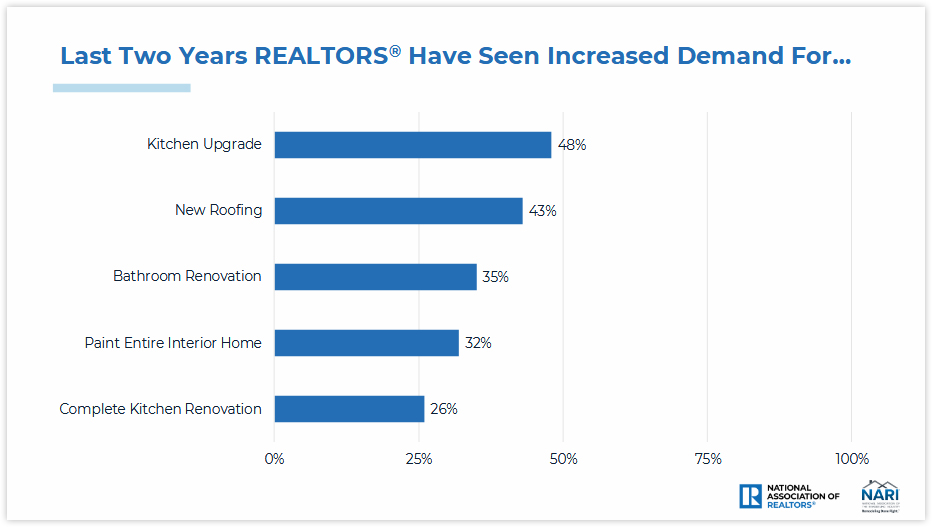Housing Forecast: 6 Predictions for 2026

The following is a summary of Windermere Principal Economist Jeff Tucker’s six predictions for the U.S. housing market and economy in 2026. He goes into more detail about his predictions in the video below.
1. Existing Home Sales Will Pick Up (Barely)
Home sales have hovered near generational lows for three years. While a sharp rebound is unlikely, conditions point to a modest uptick in 2026. Inventory levels are higher than they’ve been since 2019, and mortgage rates are lower than they’ve been since 2022. Together, those factors should lift existing home sales—but not by much.
2. Home Prices Will Be Roughly Flat
Home prices are likely to remain flat in 2026, largely due to higher inventory putting downward pressure on values. The Case-Shiller Home Price Index showed small declines last summer, though that trend faded by fall. Sellers have been highly responsive to market shifts, often de-listing when offers fall short or holding off on listing altogether. That restraint has kept prices from falling further despite growing supply
3. Inventory Will Climb to Pre-Pandemic Levels
The number of homes for sale will likely return to pre-pandemic levels in 2026, possibly as early as spring. Inventory rose sharply in 2025, and a “shadow supply” of homes—those whose owners are waiting for better conditions—remains in the wings. Many “discretionary sellers” will continue testing the market, holding out for the right price. That behavior should extend average time on market and boost total listings, giving buyers more options and negotiating power.
4. The Homeownership Rate Will Decline
At current prices and interest rates, homeownership remains out of reach for many middle-class Americans who would have bought in different conditions. Slower rent growth has also reduced urgency among would-be buyers, encouraging them to stay put. More renters are opting for single-family homes to enjoy the space and lifestyle of ownership without a mortgage, a shift that will help push the overall homeownership rate slightly lower.
5. Mortgage Rates Will Decline Slightly
Mortgage rates should remain below 6.25% for most of 2026 and could briefly dip under 6%. The Fed’s rate cuts and slower growth have brought 10-year Treasury yields near 4%, while the spread between Treasuries and mortgage rates has narrowed toward its normal range of 2% or less. That trend is expected to continue as refinance risk on mortgage-backed securities gradually fades, but much of the improvement is already reflected in current rates, so significant declines are unlikely.
6. We Will Avoid a Recession in 2026
The U.S. economy weathered several shocks in 2025 but avoided a downturn. Payroll gains have slowed, though more due to shrinking labor supply than weak demand, and unemployment claims have remained stable. After early trade policy turbulence, corporate earnings rebounded strongly, and tariff concerns have faded as court challenges and new trade deals rolled back some of the costliest restrictions.
This article originally appeared on the Windermere blog December 2, 2025.

We earn the trust and loyalty of our brokers and clients by doing real estate exceptionally well. The leader in our market, we deliver client-focused service in an authentic, collaborative, and transparent manner and with the unmatched knowledge and expertise that comes from decades of experience.
© Copyright 2025, Windermere Real Estate/Mercer Island.
2025 Holiday Happenings Around the Sound

Just in time for its darkest days, Greater Seattle is getting a glow-up! These dazzling favorites are sure to light up your holidays and banish those rainy day blues. Bring an umbrella and bask in breathtaking outdoor light shows, or cozy up and enjoy from the comfort of a cruise ship or theater seat…
SEATTLE EVENTS
Winterfest at Seattle Center
This month-long festival features sparkling lights, holiday shopping, and live entertainment (including ice sculpting!) all building up to the New Year’s Eve Celebration with fireworks.
305 Harrison Street, Seattle, WA 98109
www.seattlecenter.com/winterfest
- Dates/Times: Nov. 28 – Dec. 31, 2025. Campus holiday lighting from Nov. 20, 2025 – Mid-April 2026; ice sculpting on Saturdays at 12 pm from Nov. 29 – Dec. 27; Winterfest train & village open daily Nov. 28 – Dec. 31 | 10 am – 6 pm; Seattle Christmas Market open Nov. 20 – Dec. 24.
- Cost: General admission is free for all ages; Seattle Christmas Market is $7-$22 for adults (buy tickets)
- Parking: Paid parking available at the Mercer Garage, 5th Ave N Garage, and Theatre Commons ADA Lot. Click here for the campus map.
- Food: A multitude of dining options await you in the Armory.
- Special Events: Movie nights on select Fridays; live stage entertainment at the Armory; the Winter Train & Village; New Year’s Eve Celebration Dec. 31 from 8 pm-12 Midnight; and more!
- Holiday Closure: Christmas day

Photo by Nitish Meena on Unsplash
Candlelight Concerts at Pacific Place
Come enjoy live music performances illuminated by the warm glow of candlelight at this free holiday and pop concert series.
600 Pine St, Seattle, WA 98101
downtownseattle.org/holiday
- Dates/Times: Every Friday from 11/28/25 – 12/19/25 | 6-7 pm
- Cost: Free for everyone
- Parking: Paid parking in the garage (enter on 6th Ave or 7th Ave), or check out the city’s Interactive Parking Map
- Food: Ample dining choices in the mall
The Nutcracker by Pacific Northwest Ballet
A favorite Northwest holiday tradition for all ages with stunning dances set to a live symphonic performance of Tchaikovsky’s Nutcracker Suite.
McCaw Hall | 321 Mercer St, Seattle
pnb.org/nutcracker
Tickets
- Dates: November 28 – December 28, 2025
- Cost: $39-$246 per seat
- Parking: Mercer Street Garage or Other Nearby Parking
- Food: Beverages and snacks are available for purchase
Westlake Center Tree Lighting
A beloved annual tradition featuring crafts, giveaways, food, and a fireworks show!
401 Pine St., Seattle, WA 98101 (Westlake Park)
downtownseattle.org/holiday
https://downtownseattle.org/events/holidays
- Date/Time: Friday, Nov. 28th from 1-6pm in Westlake Park (tree lighting is at 5pm).
- Cost: Free for all ages
- Parking: Access the Westlake Tower Garage from Olive Way between 4th & 5th Ave, or check out this interactive map of city parking

Photo by Lokesh Singh Masania on Unsplash
WildLanterns at Woodland Park Zoo
Immerse yourself in a series of trails illuminated by magnificent, interactive, animal-themed lanterns.
West Entrance: 5500 Phinney Ave. N, Seattle, WA 98103
South Entrance: 750 N 50th St, Seattle, WA 98103
www.zoo.org/wildlanterns
Tickets
Map
- Dates/Times: Open nightly Nov. 14, 2025 – Jan. 18, 2026 | 4:00 – 9:00 pm.
- Cost: $32.45 – $40.95 per person (ages 2 & under are free).
- Promotions: Zoo members get 20% off tickets; Holiday Senior Stroll on Nov. 25 with 40% off for ages 65+
- Parking: Paid parking is available in all lots after 3:30 pm (here is a map). If you’re planning to purchase tickets in person, park by the West Entrance (Penguin, Otter, or Bear Lot).
- Food: Dining options available in the zoo, including The Frosted Glass 21+ space. You are also welcome to bring your own food & non-alcoholic beverages.
- Special Activities: Night Owls 21+ events; Holiday Senior Stroll; Themed Nights; Private Snow Globes; Nightly live performances in the PACCAR Auditorium; Zoomazium; ZooStore; Carousel; Sensory-Friendly Zoomazium Nightlights Daily from 4:30-8:30; Low-Sensory Nights on Dec. 2 & Jan. 8.
- Closures:
- November 17 – 20, 24, 27
- December 1, 8, 15, 24 – 25
- January 5 – 7, 12 – 14

Photo by Adobe Stock
EASTSIDE/SOUTH EVENTS
Garden d’Lights at Bellevue Botanical Garden
Each holiday season, the Bellevue Botanical Garden’s flowers, birds, animals, and cascading waterfalls are re-imagined in over half a million dazzling lights.
12001 Main Street, Bellevue WA 98005
gardendlights.org
Tickets (must be purchased online)
- Dates/Times: Open nightly Nov. 29 – Dec. 31, 2025 | 4:30 – 9:30 pm
- Cost: $10 per person (ages 10 and under are free)
- Promotions: Discounted $5 ticket nights Dec. 1-4 and 8-11 | 4:30 – 8:30 pm. Sensory Friendly Night Dec. 2nd
- Parking: Premium parking is $5 per car in the Garden’s lot as space allows OR park for free at Wilburton Hill Park
- Food: Hot drinks and snacks are available for purchase (each guest may also bring one individual beverage and small snack). Larger outside food items are prohibited.
- Holiday Closures: Christmas day
Snowflake Lane at the Bellevue Collection
This popular nightly parade features festive floats, live musicians, and even the magic of falling snow.
Bellevue Way & NE 8th Street, Bellevue WA 98004
bellevuecollection.com/snowflakelane
- Dates/Times: Nightly Nov. 28 – Dec. 24, 2025 | 25 minute parade starts at 7 pm
- Location: Bellevue Way from NE 4th Street to NE 8th Street, between Lincoln Square and Bellevue Square
- Cost: Free for all ages
- Parking: Free parking at Bellevue Square, Bellevue Place, Lincoln Square, and Hyatt Regency
- Food: A variety of dining options (from happy hour, to kid fare, to gourmet) are all within walking distance
- Special Events & Activities: Ice Skating Nov. 21 – Jan. 19; Santa Photos Nov. 28 – Dec. 24

Photo by Adobe Stock
Christmas Ship Festival
Set sail on a holiday-themed cruise complete with live choral music and hundreds of lights—a 75-year Northwest tradition!
Launch locations include Pier 55 (Seattle) | AGC Marina | Carillon Point Marina
Foss Waterway Seaport (Tacoma) | Hyatt Regency (Renton) | Kirkland City Dock
Lake Union Park (MOHAI) | Leschi Marina | Port of Edmonds
www.argosycruises.com/christmas-ship-festival
Tickets
Map
- Dates/Times: Click here for the full schedule
- Cost: $54 – $76 per adult (discounts for youth, kids 3 and under are free)
- Parking: Varies by location – click here for details
- Food: Snacks and drinks available for purchase on the ship. Outside food/drinks are not allowed.
- Special Events: Opening Night; Parade of Boats; Grand Finale
Clam Lights at Gene Coulon Park
This shimmering display spans the southeast Lake Washington waterfront for a walk to remember, along with festivities and a visit from Santa on opening night.
1201 Lake Washington Blvd N, Renton, WA 98056
rentonwa.gov
- Opening Night on Dec. 5th: Tree lighting & Santa at 6:15 pm; Santa photos from 6:30-8:30 pm; Singalong with Staff at North Shelter from 7:15-8 pm; Parade of Boats from 7:45-8:15 pm; Argosy Christmas Ship arrival & caroling from 8:20-8:40 pm
- Dates/Times: Open nightly from 12/6/25 – 1/3/26 | 5-9 pm
- Cost: Free for everyone
- Parking: Free parking is available at the park
- Food: Ivar’s Seafood Bar & Kidd Valley in the park are open daily until 8 pm
Zoolights at Point Defiance Zoo & Aquarium
Going on it’s 38th year, this magical stroll through the zoo at night is a sparkling wonderland lit by over 1.5 million lights.
5400 N Pearl St, Tacoma, WA 98407
www.pdza.org/zoolights
Tickets
Map
- Dates/Times: Open nightly Nov. 28, 2025 – Jan. 4, 2026 | 4:30 – 10 pm
- Cost: $14-$20 (free for kids 2 & under)
- Promotions: Discounted tickets for zoo members
- Parking: Free parking in zoo lots (carpooling recommended)
- Food: Dinner, drinks & snacks are available at the Plaza Cafe & outside stands. Try the new cinnamon roll on a stick, or a hot cocoa float.
- Activities: Dog Nights Dec. 1, 3, 9, & 10; Carousel; Groovy Goats
- Holiday Closures: Christmas Eve & Christmas day
But wait, there’s more…
Holiday Ice Skating Rink in Occidental Square
Sounds of the Season Caroling at Pioneer Park
Holiday theatrical & musical shows
“A Christmas Carol” at ACT Theatre
“Wonderland: A Carnival of Winter Wonder” at the Can Can
The Great Figgy Pudding Caroling Competition
The Polar Express train ride at Mt. Rainier Railroad
Gingerbread Village at the Sheraton Grand Seattle
Santa Limited Train in North Bend
Festival of Trees & Teddy Bear Suite at the Fairmont Olympic
Gingerbread Village at Sheraton Grand Seattle

We earn the trust and loyalty of our brokers and clients by doing real estate exceptionally well. The leader in our market, we deliver client-focused service in an authentic, collaborative, and transparent manner and with the unmatched knowledge and expertise that comes from decades of experience.
© Copyright 2025, Windermere Real Estate/Mercer Island.
10 Tips for Low-Stress Holiday Hosting

Hosting a crowd for the holidays is an honor…and sometimes a major source of anxiety. Whether entertaining is a dream or your worst nightmare, a little prep can go a LONG way toward reducing your workload and worries. Here are some of our favorite hacks to lower your stress level plus a cheat sheet on how much to serve.
1. Share the Load
When it comes to cooking, you don’t have to go it alone. Plan the menu and delegate sides to guests, or go potluck style and let everyone show off their favorite recipes. Just be sure to coordinate so that you don’t end up with 5 sweet potato casseroles—free websites like Evite and SignUpGenius allow attendees to sign up for a requested item or share what they’re bringing with the rest of the group. Those who don’t cook can handle beverages or pre-bagged salad kits. Here’s a guide on how much food to plan for.
2. Outsource Where You Can
Along those same lines, you can lighten your load even more by taking advantage of pre-made foods. Know your strengths and let the pros handle the rest. Anything from pies, to a smoked turkey, to the entire meal can be ordered in advance…heat it up, slap it on a serving dish, kick back, and look like a genius. Just be sure to order as early as possible in case other people are equally smart.

3. Buy Non-Perishables in Advance
Few things are as frustrating as fighting your way through holiday crowds at the grocery store only to find they’re sold out of everything you need. Beat the rush (and the stress) by making a list of the shelf-stable items you’ll need and buying them a few weeks in advance. Make some space in the pantry and you’ll be ready roll when the big day approaches.
4. Tame Your Pre-Cleaning
In the quest for perfection, how many of us have spent the day before a holiday frantically vacuuming under the bed? The reality is that people will really only see your public living areas and guest bath…so focus the deeper cleaning there. Avoid the last-minute rush by setting up a schedule of manageable cleaning tasks that can be accomplished over the weeks leading up to the event (and delegate to other household members, too!).
5. Prep Veggies, Sides & Desserts
A few days before, look over your menu and pre-chop any veggies that your recipes call for—they’ll store well in the fridge and make things so much easier on the big day. You can also make mashed potatoes in advance; reheat them by adding a splash of milk and butter then warming on the stove, baking in a 350ºF oven for 25-30 minutes, or microwaving on half power and stirring every 2 minutes until hot. Casseroles can be similarly reheated in the oven or microwave. Pies often taste better the next day anyway, so make those in advance, too!

6. Choose & Label Serving Dishes
The day before, select which serving dishes you’d like to use for each menu item. Label them with post-it notes. Not only does this make it easy for guests to help you plate things up, it also prevents you from forgetting to serve something hiding in the fridge…ahem, not that we’ve ever done that.
7. Set the Table the Night Before
A beautiful table is the perfect way to welcome guests—but don’t leave it for when you’re scrambling to do 20 other things at once. Instead, set it the night before and take all the time you need to fuss over which fork goes where. A store-bought centerpiece is an easy way to jazz things up, or, if you’re the creative type, make use of seasonal gourds and branches to create your own. LED candles are another easy way to add ambiance without lighting the napkins on fire.
8. Set Up a DIY Drinks Station
A stylish beverage station is a fun way to relieve one more burden while you’re trying to prep dinner. You can pre-mix a few pitchers of cocktails/mocktails in advance, or put out an assortment of key mixers with recipes. Include an ice bucket or cooler for cans. A good rule of thumb is to have enough supplies for about 1 drink per guest per hour. A coffee and cocoa station with flavored mix-ins is great for after dinner, too.
9. Lighten Your Post-Cleaning Load
A little planning will make that daunting clean-up routine WAY easier. Empty your dishwasher and fill your sink with soapy water before guests arrive—that way it’s easy to toss in dirty dishes and avoid a pile-up. Consider making use of newer sustainable, compostable/recyclable (and cute!) disposables that can cut down on the dish load. Parchment paper or a foil roasting pan can also eliminate scrubbing for large, hard to clean pans. Give kids the “special job” of clearing dishes from the table…usually they’re happy to help (especially with dessert time as an incentive).
10. Focus on the Fun
Hosts often feel pressured to be perfect…but the truth is that everyone is happiest when you’re happy. Having fun is much more memorable and meaningful than how moist the turkey turned out or whether you forgot to dust the chandelier. In fact, some of our favorite holiday memories are often when things didn’t go right and we all laughed over it (think accidentally leaving the bag of giblets in the turkey, or Grandpa cutting through the cord of the electric carving knife and sending sparks flying through the kitchen).
If hosting triggers anxiety for you, build in some self-care that will help you re-center and relax when things feel overwhelming. Putting on some uplifting music, enlisting your favorite optimist to help on the big day, or simply repeating the mantra, “All I can do is my best” can work wonders to relieve stress. Lastly, sharing the burden of cooking and cleaning means you can also share successes and failures…so let go of that pesky fear of judgement and focus on the “together.” Isn’t that really what it’s all about, anyway?
Bonus Cheat Sheet!

We earn the trust and loyalty of our brokers and clients by doing real estate exceptionally well. The leader in our market, we deliver client-focused service in an authentic, collaborative, and transparent manner and with the unmatched knowledge and expertise that comes from decades of experience.
© Copyright 2025, Windermere Real Estate/Mercer Island.
Stock photos courtesy of Adobe Stock, Unsplash and Pexels.
How’s the Market? Q3 2025 Review of Seattle Area Real Estate

Summer brought balance to the Greater Seattle housing market, with most homes taking longer to sell and often going for below list price. The most desirable homes are still selling above list price—but it’s safe to say that the days of multiple offer frenzies are behind us for the present. Median sales prices held fairly steady with a modest 4% year-over-year gain in Seattle and slight 1% dip on the Eastside.
Our advice to home sellers is genuine and has carried over from Q2: well-priced, well-prepared homes still move quickly, but overall, the frenzy of spring has eased into a steadier rhythm. The first 10 days matter more than ever. For buyers, with more listings than last year and slower sales coupled with lower interest rates, you have a selective advantage and opportunity to find a great property. If single family homes are starting to feel out of reach, don’t overlook the townhome and condo market. It’s been a fantastic option for buyers looking for value and convenience!
Click or scroll down to find your area report:
Seattle | Eastside | Mercer Island | Condos | Waterfront
SEATTLE
Seattle went from a hot spring to a balanced summer! And boy, did Seattle show off when it comes to growth in the numbers. While the summer market shifted to a steadier pace, the city’s median home price landed at $980,000, 4% above last year but slightly below Q2’s peak. Homes took longer to sell, and bidding wars eased as buyers gained more breathing room much like the Eastside. Still, well-priced listings in popular neighborhoods like West Seattle and North Seattle continued to move quickly and often close to asking price.
Inventory remains healthy, giving buyers options and sellers the chance to stand out through pricing and presentation. Urban cores such as Capitol Hill (+16%) and North Seattle (+18%) held firm, while areas like Ballard and Queen Anne saw small seasonal dips. 48% of homes sold within the first 10 days at their listing price or above, 27% of which experienced multiple offers. Overall, Seattle’s housing market remains strong—just more measured and thoughtful as we head into fall.
Click here for the full report and neighborhood-by-neighborhood statistics!
EASTSIDE
After a bustling spring market, summer brought a welcome dose of balance across the Eastside. Remember, last quarter, 66% of homes sold at or above their listing price in the first 10 days. This quarter, under half the properties (43%) had the same results. Median home prices held steady at $1,560,000, just 1% below last year, while the pace of sales slowed as buyers gained breathing room. With fewer bidding wars and longer market times, many buyers had the opportunity to compare options and negotiate.
Rising inventory and selective buyers mean strategy matters more than ever. Sellers who price accurately and make a strong first impression are still achieving great results, especially in desirable neighborhoods like West Bellevue and Kirkland. Buyers, meanwhile, are finding opportunities in Redmond (+ 8%), and East Bellevue (+ 26%) as prices soften slightly. The Eastside market remains healthy, just more measured and thoughtful as we head into fall. There is a luxury resilience as well—West Bellevue and Mercer Island held firm proving that well positioned homes still move if priced right.
Click here for the full report and neighborhood-by-neighborhood statistics!
MERCER ISLAND
After a lively first half of 2025, Mercer Island’s market eased into a steadier rhythm this summer. The median sale price held at $2,413,000, which was nearly identical to last year (but down from last quarter’s $2.5M median price) with 70 total sales vs. 72. Fewer homes sold in bidding wars or within the first 10 days, but well-priced, move-in-ready listings continued to attract strong attention. The North End and East Seattle neighborhoods led in pricing, with select properties exceeding $5M, while most of the Island maintained stable values.
The shift from spring’s fast pace to summer’s calmer tempo signals a more thoughtful market on Mercer Island. Sellers can expect longer market times but solid results when listings are priced strategically and presented beautifully. Buyers, meanwhile, will find a bit more room to negotiate and a wider selection across price points (60% of the homes that sold on the island sold below their original listing price) particularly appealing as single-family inventory remains limited region wide. Mercer Island continues to demonstrate both resilience and lasting desirability heading into fall.
Click here for the full report and neighborhood-by-neighborhood statistics!
CONDOS – SEATTLE & EASTSIDE
After a busy spring, Seattle area condos entered a steadier phase this summer. Median prices eased slightly to $600,000 region-wide, while average price per square foot dipped 3%. Fewer bidding wars and longer market times gave buyers more room to negotiate, especially in core city neighborhoods. Even so, affordable communities like Ballard (+52%!) and South Seattle (+47%) remained bright spots, showing that well-priced listings continue to draw attention. Specifically, of 157 condo sales in Ballard/Greenlake, 60 of those sales were new construction, a hot segment of the market right now.
On the Eastside, condos held their value and continued to offer a more attainable path to homeownership than single-family homes. Woodinville and Mercer Island posted notable price gains, while overall competition moderated from spring levels. With condos under $700K still in good supply, there’s a strong opportunity for buyers seeking value and location without sacrificing quality.
Our advice to condo sellers: price realistically, present well and have patience with the longer market times, especially if you’re selling a downtown luxury product. For buyers, this is the best condo buying environment we’ve seen in over a year. With more listings than last year and slower sales coupled with lower interest rates, you have a selective advantage and opportunity to find a great property.
Check out area-by-area details in the full condo report.
WATERFRONT
Seattle waterfront picked up this summer with 10 sales (as opposed to just 4 in the spring). Eastside and Lake Sammamish also stayed busy with 11 and 9 waterfront sales respectively. Only 2 homes sold above their list prices—the vast majority sold below list, with only a few selling right at the asking price.
West Bellevue saw the highest sale, with a nearly 9,000 sq. ft., shy half-acre estate on 80 feet of Meydenbauer Bay waterfront fetching over $20 million. The most affordable home was a cozy bungalow on 100 feet of Lake Sammamish waterfront that went for $1.5 million.
This brief overview of the entire Seattle-Eastside private waterfront market, including Mercer Island and Lake Sammamish, illustrates the trends occurring in our region over time. This data is interesting and insightful but cannot replace an in-depth waterfront analysis with your trusted professional.
View the full waterfront report

We earn the trust and loyalty of our brokers and clients by doing real estate exceptionally well. The leader in our market, we deliver client-focused service in an authentic, collaborative, and transparent manner and with the unmatched knowledge and expertise that comes from decades of experience.
© Copyright 2025, Windermere Real Estate/Mercer Island. Information and statistics derived from Northwest Multiple Listing Service and Trendgraphix, and deemed accurate but not guaranteed. Mercer Island cover photo courtesy of The Sirianni Group; by Andrew Webb, Clarity Northwest Photography. Condo cover photo courtesy of Luke Bartlett, by Matthew Gallant, Clarity Northwest Photography.
Renting vs Buying: Which is Better for You?

Knowing whether it’s the right time to rent or buy depends on your buying power, what you’re looking for in a home, your local market conditions, your plans for you and your household, and the responsibilities you’re prepared to take on at your residence.
Renting gives you greater flexibility to relocate, fewer home maintenance responsibilities, and can often be more the more affordable option, depending on where you live. The extra costs associated with owning a home—interest payments, taxes, repairs—may be too much for some renters to handle.
Becoming a homeowner also has its advantages. From a financial standpoint, owning is usually better than renting in the long term—it allows you to build wealth as your property gains equity; your monthly payments are stable and actually become more affordable over time relative to your income; and some of the costs may be deductible at tax time. From a lifestyle standpoint, owning also affords you greater freedom to customize your living space.
Ultimately, the right decision depends on your situation. If you don’t plan to be living in the same place for at least five years, renting might be more logical, as it allows you more flexibility when it comes time to move again. If you’re looking to settle down for the better part of a decade or longer and can afford to buy a home, becoming a homeowner may be the better option. Here are a few additional considerations to guide your renting-versus-buying decision making process.
What are the local real estate market conditions?
Investigate the local sales and rental markets to get an idea of both typical home prices and the average monthly payment for a rental. When comparing housing costs, be sure to base your evaluation on what’s happening in your city and neighborhood, not the nationwide averages. I track these stats regularly, so feel free to contact me for an accurate update on prices in your neighborhood.
For a quarterly breakdown of local market conditions in the Seattle area, explore my Market Review page. Each report breaks down the latest figures in home sales, home prices, and days on market for regions throughout Seattle and the Eastside. They also include helpful insights and data analysis.
What can you afford?
Making the jump from renter to homeowner is often a question of affordability. Your mortgage rate will depend on your financial strength, your credit score, and other factors, so make sure to talk to a loan officer before you start looking for a home. Getting pre-approved for a mortgage will identify what you’re able to afford and helps strengthen your offer when the time comes.
To get an idea of what you can afford, try these Financial Calculators. You can estimate your monthly payment for any listing price/mortgage terms to get a well-informed picture of whether it’s the right time to buy.
Will you need to make repairs to your new home?
Buying a fixer-upper may seem like a great way to get a deal on a house, but if the money you spend on the repairs is too great, your profit could be diminished when it comes time to sell. The same is true for remodeling and improvement projects. There are various renovation financing loans available to you that can help with the costs of home repairs, though extra consultations, inspections, and appraisals are often required in the process of securing these loans. Ultimately, if you can only afford a home that demands major improvements, and you don’t have the skills to do much of the work yourself, you may be better off renting.
Can you rent part of the house you’re buying?
If you buy a house with rental-capable space (extra bedroom, mother-in-law unit, etc.), you could use the rental income to pay off your mortgage faster and contribute more to your savings. But, of course, you need to be willing to share your home with a tenant and take on the responsibilities of being a landlord or working with a professional property manager to help you with those duties. Renting out a space in your home will also require you to purchase landlord insurance on top of your existing homeowners insurance policy.
Making Your Decision to Rent or Buy
At the end of the day, the decision is up to you. Based on the conditions laid out above, it simply may not be the right time for you to buy. Fortunately, when it comes to being a homeowner, it’s not now or never. I’m happy to be your resource in gauging whether it’s the right time to buy and guiding you through the process toward homeownership. To get started, connect with me today.

We earn the trust and loyalty of our brokers and clients by doing real estate exceptionally well. The leader in our market, we deliver client-focused service in an authentic, collaborative, and transparent manner and with the unmatched knowledge and expertise that comes from decades of experience.
© Copyright 2025, Windermere Real Estate/Mercer Island.
Adapted from an article that originally appeared on the Windermere blog April 11, 2022.
Adding an ADU? Here’s a Guide to Permits & Regulations…

ADUs and DADUs are increasingly popular among homeowners looking to maximize their property value. For many cities in Washington State, the recent enactment of House Bill 1337 has made it easier for homeowners to add an ADU/DADU by loosening restrictions on them in residential areas. Other states have enacted similar laws as municipalities across the country try to address our shortage of “middle” affordable housing.
As the movement of short-term rentals, turnkey properties, and real estate investment continues to grow, it’s worth it to take a moment and understand the regulations that dictate a property’s potential—especially before you buy. Understanding a bit about the permitting process will also help you avoid getting bogged down in legalities when trying to build structures on your property.
What is an ADU, and do I need a permit to build one?
 Accessory Dwelling Units (ADUs) and Detached Accessory Dwelling Units (DADUs) are essentially guest quarters that offer independent living space for renting out or accommodating multi-generational family members. Typically, they include a separate entrance, kitchen, living area, bedroom, and bathroom. Common examples are a basement apartment, converted garage, backyard cottage, or prefab modern shed. They’re a great way to get the highest return on your property investment. Before you break ground on your building project, however, here are some of the things you should keep in mind.
Accessory Dwelling Units (ADUs) and Detached Accessory Dwelling Units (DADUs) are essentially guest quarters that offer independent living space for renting out or accommodating multi-generational family members. Typically, they include a separate entrance, kitchen, living area, bedroom, and bathroom. Common examples are a basement apartment, converted garage, backyard cottage, or prefab modern shed. They’re a great way to get the highest return on your property investment. Before you break ground on your building project, however, here are some of the things you should keep in mind.
- Permits and Regulations: No matter where you live, it is necessary to obtain an appropriate permit before you begin the construction/conversion process. Permits ensure that your project complies with local building codes and regulations (and also allow you count that square footage as living space when you sell the property or have it appraised). Here are ADU regulations for King County, or check with your local city/county.
- Code Compliance: Building codes aren’t just red tape for the sake of red tape; they exist to make sure that all buildings are safe. Whether you’re building the structures on your property yourself or hiring a professional to do the job, familiarize yourself with your local codes and regulations. In the city of Seattle, HB 1337 allows homeowners to build at least two 1,000 sq. ft. ADUs per lot (whether attached or detached). Contact your local zoning department or building authority to learn more.
- Applying for a Permit: The permit application process varies by location. Typically, you’re required to submit detailed plans for your project with documents that outline its scope, size, etc. Whether you submit architectural drawings, engineering plans, or some other form of detailed blueprint, be prepared for a thorough review on behalf of your local authority to make sure your project complies with the rules.
Whatever project you have in mind—whether converting existing structures or building new ones—it’s important to become well-versed in the permits and regulations that will allow you to get it approved hassle-free. Consult with local authorities to get the full picture of what’s required from you. Once you’ve checked all the boxes, you’ll be well on your way to maximizing the value of your property.
Curious what your return on investment might be when it’s time to sell? Contact me for a Comparative Market Analysis. I can also put you in touch with a property management company to estimate market rental rates in your area.
Adapted from an article that originally appeared on the Windermere blog September 6, 2023.

We earn the trust and loyalty of our brokers and clients by doing real estate exceptionally well. The leader in our market, we deliver client-focused service in an authentic, collaborative, and transparent manner and with the unmatched knowledge and expertise that comes from decades of experience.
© Copyright 2025, Windermere Real Estate/Mercer Island.
7 Common Scams to Avoid

Whether through email, text, malicious websites, or phone, scammers are constantly trying to separate you from your money. Tactics range from a simple fake website to elaborate schemes in which people assume a false identity and convince you to wire them thousands of dollars; they may even come back for Round 2 and scam you a second time by pretending to help you recover your lost funds. Big red flags are pressure to act quickly and requests for money in the form of a wire transfer, gift card, cryptocurrency, or other untraceable payment. You should also pause if any person or company—even one you know and trust—is asking you for personally identifiable information (your bank or employer will never email you to ask you to verify your username, password, or PIN).
In real estate, we are constantly striving to protect our clients from fraudsters. We consulted both our experience and the FBI’s fraud department to bring you this list of common scams and how to avoid them…
1. Rental Scams
HOW THEY WORK:
Scammers offer a bogus rental opportunity and pressure potential renters into sending personal information and/or money for fees, deposits, or rent.
HOW TO PROTECT YOURSELF:
- Beware of “too good to be true” rental offerings, particularly those with a sense of urgency and anyone not willing or able to meet in person.
- Confirm that the property is actually for rent by cross-checking on multiple websites and confirming the contact info matches—don’t trust links sent to you by email or text.
- Don’t give away personal information before the touring the property or in response to unexpected requests.
- Tour the property in person, or have your agent or a trusted friend/family member tour it for you if you’re out of area. Note: some scammers will actually meet you at the property and may even have a code to get into the lock-box, which leads us to…
- Vet the person offering the rental. If they’re emailing you, check the domain name after the @ carefully (if it’s something generic like @gmail, be extra cautious since those can be created by anyone). If it’s a service, check their reviews on the Better Business Bureau and other review sites. You can also ask for a business card; if they’re an agent, ask for their license number and check it against the state database (here is Washington’s). If you’re working with someone claiming to be the owner, check county records to ensure their name matches the owner on record.
- Never pay any fees, deposits or rent via wire transfer, cryptocurrency, gift cards, or a sketchy website you don’t recognize. Use traceable methods like an ACH transfer through your bank, or a debit/credit card…after you’ve vetted the person and the listing.
2. Business & Investment Fraud
HOW IT WORKS:
- Advance fee schemes convince victims to invest money up front for a future, larger return that never comes.
- “Nigerian Prince” letter schemes promise you a cut of some huge sum of money in exchange for helping someone illegally transfer it out of their home country.
- Ponzi schemes collect money for a bogus investment, and then use incoming money from new investors to pay previous investors until the whole thing collapses.
- Pyramid schemes operate like a hierarchy where you send money to people above you and are promised huge returns by bringing in new investors below you. People at the bottom lose…and the whole setup is illegal.
- Telemarketing fraud schemes coerce money from you over the phone by claiming you won a prize, convincing you you’re in legal trouble, and any number of other imaginative claims.
- Cryptocurrency investment fraud involves scammers manipulating victims into depositing fake “investments” via cryptocurrency; in the end, they lose all of the money they invested to the criminals.
HOW TO PROTECT YOURSELF:
- If it sounds too good to be true, it probably is. There is no such thing as a guaranteed return, and you should be wary of anyone promising you’ll get rich quick.
- Never rush into an investment opportunity. Pressure to invest now and “get in the ground floor” is a red flag that you’re probably being scammed, especially if they ask you not to tell anyone about it.
- Never invest on the advice of someone you meet solely online. This includes strangers and people claiming to be long-lost contacts on social media.
- If you believe you’ve been victimized, don’t pay additional fees/taxes to access your money. This is part of the scam, as well as any service that claims it can help you recover your lost funds.
3. Home Purchase Wire Fraud
HOW IT WORKS:
You receive a message that looks like it’s from a trusted sender, giving you instructions on wiring money for making a payment during the home buying process. The money goes straight into the fraudsters’ account.
HOW TO PROTECT YOURSELF:
- Pre-plan the closing process, discussing payment options with your lender. Call them directly and ask specifically about instructions for wiring funds (don’t ask for this over email since scammers usually operate by compromising the email address of one the parties).
- Record contact information for trusted people involved in your purchase process, including your agent, lender, title company, and attorney. If someone new reaches out, confirm their identity by speaking directly with one of your trusted contacts.
- Call a known number to confirm wiring instructions before sending any transaction through. Talk to one of your trusted contacts and ask them to repeat the wiring information to confirm it’s legit. Call again after the transfer to ensure that funds were received.
- Watch for red flags like someone saying that you previously sent funds incorrectly, that they were never received, that there are new instructions for payment, or that there has been a last-minute change to the closing process. Call a trusted contact immediately.
- Read our full article on wire fraud.
4. Timeshare Fraud
HOW IT WORKS:
Fraudsters claim to help timeshare owners exit, rent, or invest their timeshares with upfront taxes or fees required (which the scammer pockets). Once the victim realizes they have been scammed, the fraudsters may re-approach them posing as lawyers, police, or government officials claiming they can help recover the lost money—again, requesting upfront fees. Some may even threaten the victim with prison time if they don’t pay up.
HOW TO PROTECT YOURSELF:
- Stop communicating with anyone who requests cash upfront for something related to your timeshare. This is true no matter which institution they appear to be with or what contracts, letters or bank account documentation they may provide (criminals do their homework and sometimes create fraudulent documents).
- Don’t send legal documents via email. Never sign, notarize, or send any power-of-attorney or other document.
- If you’ve been scammed, stop sending money, file a report with the FBI’s Internet Crime Complaint Center (IC3) and only work with them. Do not communicate with anyone who claims to be a government official reaching out about a settlement, threatening to arrest or prosecute you if money isn’t paid, or threatening to subpoena you.
5. Fraudulent Charity Scams
HOW THEY WORK:
Criminals exploit tragedies, natural disasters, or political events to seek donations for fake charities.
HOW TO PROTECT YOURSELF:
- Give to trusted charities/groups by manually typing out the web address. Don’t click on links or open attachments to donate. Look out for organizations with copycat names trying to impersonate reputable organizations.
- Vet charities before you give by using a site like the BBB Wise Giving Alliance, Charity Watch, or Charity Navigator. You can also search the charity’s name plus “complaint,” or “scam.”
- Give using a check or credit card. Avoid any request to donate via cash, gift card, virtual currency, or wire transfer—it’s probably a scam.
6. Elder Fraud Schemes
HOW IT WORKS:
- Romance scams involve scammers who use the illusion of a relationship to manipulate and steal from the victim.
- Tech support scams allow criminals to gain access to victims’ devices and sensitive info by posing as support reps and offering to fix non-existent computer issues.
- Grandparent scams involve criminals impersonating relatives in urgent financial need to extort money from victims.
- Home repair scammers charge homeowners in advance for home improvement services that never happen.
- Sweepstakes/lottery scams convince the victim they have won a large prize that they can collect for an upfront “fee.”
- Government impersonation scams extort money from targets by frightening them into believing they must provide funds or payments to avoid arrest or prosecution.
HOW TO PROTECT YOURSELF & YOUR FAMILY MEMBERS:
- Never send money, gift cards, or valuables to anyone you have only communicated with online or by phone. In addition, never send sensitive financial information or inappropriate photos that could later be used to extort money from you.
- Create a shared verbal password that only you and your loved ones know.
- Be wary of unsolicited calls, mailings, and door-to-door service offers. Vet any contractors before you hire them (especially anyone requesting payment before work is performed). Be aware that legitimate tech support services will never reach out to say something is wrong with your computer.
- Resist the pressure to act quickly. Scammers use urgency and fear to coerce victims into immediate action.
7. Spoofing & Phishing
HOW IT WORKS:
- Spoofing is when someone impersonates a trusted person or company by disguising their email address, name, number, or website.
- Phishing schemes typically use spoofing to get you to think you’re on a legitimate site, then obtain your password, credit card number, banking PIN, or other sensitive info by making you think you need to update or verify your personal information.
- Variations include Vishing (same thing but over phone or VM), Smishing (phishing via SMS text message) and Pharming (your computer is infiltrated with malicious code that redirects you to fake websites).
HOW TO PROTECT YOURSELF:
- Don’t trust any company reaching out to you for your username and password—they don’t do that. Even if it’s a company you know and use, avoid clicking on any links and instead call the company directly using their official phone number to confirm if the request actually came from them.
- Pay careful attention to spelling in email addresses and websites. Spoofers often use email addresses or web addresses that may be just one letter off from the genuine ones.
- Set up two-factor authentication for all of your password-protected accounts. This adds an extra layer of security that can protect you even if a phisher obtains your username and password.
You can find information on more scams and how to avoid them on the FBI’s website. When in doubt if something is legit, stop communications and call the company directly or consult a trusted advisor like your attorney, family members, or real estate agent. If you feel you’ve been the victim of the scam, contact police directly and/or report it to ic3.gov, the FBI’s Internet Crime Complaint Center (IC3). Do not engage with anyone who reaches out to you claiming they can help you recover your lost funds.

We earn the trust and loyalty of our brokers and clients by doing real estate exceptionally well. The leader in our market, we deliver client-focused service in an authentic, collaborative, and transparent manner and with the unmatched knowledge and expertise that comes from decades of experience.
Sources:
https://www.fbi.gov/how-we-can-help-you/scams-and-safety/common-frauds-and-scams
https://consumer.ftc.gov/features/donating-safely-and-avoiding-scams#research
https://www.windermere.com/blog/what-is-wire-fraud-and-how-to-avoid-it
How’s the Market? Q2 2025 Review of Seattle Area Real Estate

The end of our spring market quieted down significantly as warm weather, graduations, and vacations distracted buyers and kicked off our typical summer slowdown. Despite this, Seattle posted modest year-over-year growth in both sales activity and median sales prices. The Eastside saw slight dips in sales prices and activity compared to last spring, but choice homes still sold quickly and most closed at or above their listed prices. Buyers found more room to negotiate, particularly on properties that needed work or otherwise didn’t generate immediate interest.
Our takeaways for Sellers: pricing strategy and early market momentum matter—homes that sell quickly are fetching the highest prices. Preparation and accurate positioning are key to success. For Buyers: There’s more inventory than last year, but the best homes are still moving fast and often over asking. Be ready to act decisively, especially in high-demand areas.
Click or scroll down to find your area report:
Seattle | Eastside | Mercer Island | Condos | Waterfront
SEATTLE
Seattle was a medal winner in the Q2 relay! Median sales price in Seattle hit $1.02M, up from $968K in Q2 2024—a 5% increase year-over-year, signaling a healthy and steadily appreciating market. Despite increased inventory, sales activity rose 3% YoY with 2,019 homes sold, reflecting stable demand. Homes that sold within the first 10 days received 105% of asking price, while those on market more than 30 days averaged just 97%, so speed continues to command premium pricing.
Momentum continues to be visible across several neighborhoods. Queen Anne & Magnolia led the city with a 14% price increase, pushing the median to $1.5m—a strong signal of those wanting quiet luxury near the downtown core. Ballard–Green Lake and North Seattle also saw notable gains, up 10% and 9% respectively. Central Seattle recorded a 6% increase in price per square foot and the highest number of units sold among central neighborhoods, showing a rebound in core urban demand. Lake Forest Park was the only area with a significant decline in median price (-9%) suggesting buyer opportunity in the near-north fringe.
Much like the Eastside, inventory jumped to 3,500 new listings in Q2, a 16% increase over Q2 2024, giving buyers more choices and slightly more negotiating room, especially for homes that linger on market.
The Seattle market in Q2 2025 showed measured growth, more listing activity, and resilient demand. Whether you’re buying or selling, strategy, timing, and clarity on your market segment are what will make the difference.
Click here for the full report and neighborhood-by-neighborhood statistics!
EASTSIDE
There was a listing surge this quarter and that was most significant on the Eastside! 3,194 homes were available—a substantial jump from just 2,509 in Q2 2024. This equates to a 27% increase in supply year-over-year. For buyers, there was more to choose from this quarter coupled with buyers being more selective and price sensitive. While competition is still strong, longer market times and slight price softening in some areas mean buyers have more negotiating power—especially in markets like Redmond and Sammamish.
But don’t rule out the homes priced and prepped well! Sales velocity remained strong, with 67% of homes selling at or above list price, and most (66%) selling within the first 10 days. 39% of homes even sold over asking price. The median sale price across the Eastside was $1.65M, slightly down from $1.67M last year (–1%), showing a stable but price-sensitive market. For those homes with a longer market time (over 30 days) on average, sellers took a 3% negotiation.
Areas like Sammamish (–7%) and Redmond (–13%) experienced the most significant price drops—indicating opportunities for buyers who are priced out of West Bellevue or Kirkland. If we’re talking community standouts, West Bellevue leads the pack in pricing, with a median sale price of $3.75M, up 5% year-over-year, and the highest price per square foot at $1,151. Kirkland saw the largest year-over-year price increase, up 8%, pushing the median to $2.19m. Redmond was the only major submarket to experience a notable increase in number of homes sold (+15%), despite a 13% price drop, suggesting high buyer demand for more affordable options.
Q2 2025 brought more listings and more choices, but the market remains fast-moving and price sensitive. Our takeaways for Sellers: pricing strategy and early market momentum matter—homes that sell quickly are fetching the highest prices. Preparation and accurate positioning are key to success. For Buyers: There’s more inventory than last year, but the best homes are still moving fast. If the home is listed, the seller is ready to make a deal. Whether you’re buying or selling, strategy, timing, and clarity on your market segment are what will make the difference.
Click here for the full report and neighborhood-by-neighborhood statistics!
MERCER ISLAND
Mercer Island’s Q2 2025 market remains robust, especially for well-positioned single-family homes. As predicted, those homes that were prepped well and priced strategically found serious buyers quickly—many selling within the first 30 days. 64% of homes sold at or above their list price this quarter, a strong signal that sharp pricing and smart timing paid off.
What’s less visible in the headline numbers is that 38 of the homes listed in Q2 are still active today. This speaks to the importance of days on market as a key driver: homes that sold within the first 10 days (71% of sales) received 102% of asking price, while those on the market longer than 30 days fetched just 96%. A 4% negotiation window suggests buyers are discerning, and sellers may be responding to increased competition while planning for a typical summer slowdown.
With 72 residential sales, Q2 showed a healthy level of activity, but overall urgency softened, leading to downward pressure on pricing. The median sales price slipped to $2,530,000 from $2,937,000 in Q1, showing that the early-year momentum didn’t carry through Spring. Still, when compared to Q2 2024’s $2.5m, pricing has remained remarkably resilient.
Neighborhood standouts: the Westside led the market with strong price per square foot and intense buyer interest – 5 of the 6 homes sold within the first 10 days. The North End saw the highest sales volume with 14 homes sold, proving to be a consistent favorite. The South End offered 7 sales at a reasonable price per square foot of $722 vs. the North End’s $885 per foot.
While the data shows a seller-leaning market, buyer demand is unpredictable. With an uncertain Fall market ahead, sellers should prepare for longer market times, and bring patience along with their listing prep. Buyers, on the other hand, should know that opportunities exist across the island, especially in the condo sector, where activity is softer and pricing may be more approachable for those looking to establish a foothold on Mercer Island.
Click here for the full report and neighborhood-by-neighborhood statistics!
CONDOS – SEATTLE & EASTSIDE
Condos remained an accessible entry point for buyers across our region, with Q2 marking a strong showing. In Seattle, the most robust demand was found in more affordable neighborhoods like South and North Seattle—North Seattle alone saw a 24% jump in median price. Meanwhile, the luxury condo segment in Downtown Seattle moved more slowly, with average price per square foot landing at $794.
On the Eastside, the condo market felt uneven but held its value overall. While pricing trends varied by submarket, Eastside condos continued to outperform Seattle in overall price strength. Woodinville and Redmond stood out with impressive gains, while Mercer Island saw a softer quarter with just four sales and a median price dipping to $618K.
Sales activity rose 7% on the Eastside and 5% in Seattle compared to last year. Homes that sold within the first 10 days garnered the most attention, suggesting well-priced listings are still commanding strong interest. In Seattle, 53% of condos sold at or above list price; on the Eastside, that number climbed to 58%—a clear sign that buyers are negotiating in a competitive environment and pricing remains fluid.
With the single-family market still tight, condos—particularly those priced under $700K—continue to offer buyers a compelling path to homeownership in desirable neighborhoods.
Check out area-by-area details in the full condo report.
WATERFRONT
Lake Sammamish and Eastside waterfront saw a busy Q2 with 13 and 9 sales respectively. After a big Q1, Seattle waterfront sales slowed in Q2 with just 4 sales (as opposed to 10 last quarter). Mirroring the overall market, waterfront saw some softening on price—the vast majority of homes sold at or below their list prices with just a few choice properties attracting bidding wars.
Yarrow Point garnered the largest sale price of $13 million for an immense Cape Cod inspired estate encompassing over half an acre, 7,465 sq. ft. of interior living spaces, and 82 feet of prime low- to no-bank waterfront. Lake Sammamish offered the best bargain—an original 1975 lake house on 1/3 acre with 50 feet of waterfront that was snagged for $2.6 million.
This brief overview of the entire Seattle-Eastside private waterfront market, including Mercer Island and Lake Sammamish, illustrates the trends occurring in our region over time. This data is interesting and insightful but cannot replace an in-depth waterfront analysis with your trusted professional.
View the full waterfront report

We earn the trust and loyalty of our brokers and clients by doing real estate exceptionally well. The leader in our market, we deliver client-focused service in an authentic, collaborative, and transparent manner and with the unmatched knowledge and expertise that comes from decades of experience.
© Copyright 2025, Windermere Real Estate/Mercer Island. Information and statistics derived from Northwest Multiple Listing Service and Trendgraphix, and deemed accurate but not guaranteed. Seattle cover photo courtesy of Codi Nelson, by HD Estates Photography. Eastside cover photo courtesy of Fred Fox & Julie Wilson by Bobby Erdt, Clarity Northwest Photography. Mercer Island cover photo courtesy of Janet Bell & Julie Wilson, by Bobby Erdt, Clarity Northwest Photography. Condo cover photo courtesy of Luke Bartlett, by Kealin Branson, Clarity Northwest Photography. Waterfront cover photo courtesy of Nancy LaVallee, by Amaryllis Lockhart, Clarity Northwest Photography.
2025-2026 Football & Hockey Schedules, Recipes, & Tips

Football is almost here and hockey is coming in hot behind it! Scroll down for printable schedules, tailgating hacks (including how to pack the perfect cooler!), and favorite gameday recipes. Fans of all ages will also love our printable football and hockey bingo sheets.
Need to brush up on your sports lingo? Check out Wikipedia’s handy football and hockey glossaries. You can say impressive things like, “Are they running a 3-4 defense?” and “It’s not icing unless the puck passes the goal line…”

We earn the trust and loyalty of our brokers and clients by doing real estate exceptionally well. The leader in our market, we deliver client-focused service in an authentic, collaborative, and transparent manner and with the unmatched knowledge and expertise that comes from decades of experience.
© Copyright 2025, Windermere Real Estate/Mercer Island.
Remodeling Impact Report: Projects That Bring Joy & ROI

Is your home ready for a refresh? Whether it’s for their own enjoyment or to prep their houses for sale, Americans are investing more and more money into remodeling each year. According to a recent report by the National Association of REALTORS® (NAR), the demand for top-condition homes is going up among buyers as well. So which projects will get you the most bang for your buck? Or, perhaps more importantly, which projects will bring you the most joy? Here’s what the Remodeling Impact Report revealed…
Projects That Boost Your Happiness
It’s easy to think about improvements in terms of monetary value…but what about the value of enjoyment and enhanced livability? As part of their report, NAR calculated a “Joy Score” for common remodeling projects based on the happiness homeowners reported with their renovations. Three projects stood out with perfect joy scores: adding a primary bedroom suite, upgrading the kitchen, and replacing roofing. Here are the projects with the highest joy scores:
Projects That Help Pay for Themselves
As a bonus to bringing you joy, many projects will also pay you back for at least a portion of their cost when it’s time to sell your home. Projects that increase your home’s curb appeal tend to bring you the highest return on investment (ROI), although closet renovation snuck in as a surprise gem:
What If You’re Remodeling to Sell?
In virtually any real estate market, a home that feels fresh, clean, modern, and move-in ready will always sell faster and for more money than its dated counterpart. This isn’t always tangible in the ROI studies but, as agents, we see it every day. The good news is that the updates you make to sell are often more cosmetic and less expensive than the upgrades you might make if you were planning to stay in the home forever (pssst…check out this article on remodeling projects you should avoid if you’re selling your home).
The two charts below show both the projects REALTORS® most often recommend sellers do before selling, and five projects we’ve seen increased demand for from buyers:
It’s critical to understand that every home, neighborhood, and situation is different. Your home’s unique characteristics and your personal goals as a homeowner will have more impact on which remodeling projects are best for you than any of these general trends. If you’re remodeling to sell, reach out for advice; I’m happy to help you choose the right projects—and avoid the wrong ones—to help you accomplish your objectives.
Data & charts copyright ©2025 “2025 Remodeling Impact Report.” NATIONAL ASSOCIATION OF REALTORS®. All rights reserved. Reprinted with permission. April 9, 2025, https://www.nar.realtor/sites/default/files/2025-04/2025-remodeling-impact-report_04-09-2025.pdf.

© Copyright 2025, Windermere Real Estate/Mercer Island.

 Facebook
Facebook
 X
X
 Pinterest
Pinterest
 Copy Link
Copy Link



